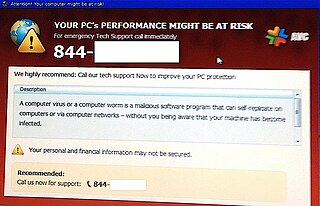Related Research Articles

Urban legends is a genre of folklore concerning stories about an unusual or humorous event that many people believe to be true but largely are not.
A chain letter is a message that attempts to convince the recipient to make a number of copies and pass them on to a certain number of recipients. The "chain" is an exponentially growing pyramid that cannot be sustained indefinitely.

Cybercrime encompasses a wide range of criminal activities that are carried out using digital devices and/or networks. These crimes involve the use of technology to commit fraud, identity theft, data breaches, computer viruses, scams, and expanded upon in other malicious acts. Cybercriminals exploit vulnerabilities in computer systems and networks to gain unauthorized access, steal sensitive information, disrupt services, and cause financial or reputational harm to individuals, organizations, and governments.
Scam baiting is a form of internet vigilantism primarily used towards advance-fee fraud, IRS impersonation scams, technical support scams, pension scams, and consumer financial fraud.
Wingdings is a series of dingbat fonts that render letters as a variety of symbols. They were originally developed in 1990 by Microsoft by combining glyphs from Lucida Icons, Arrows, and Stars licensed from Charles Bigelow and Kris Holmes. Certain versions of the font's copyright string include attribution to Type Solutions, Inc., the maker of a tool used to hint the font.

Internet fraud is a type of cybercrime fraud or deception which makes use of the Internet and could involve hiding of information or providing incorrect information for the purpose of tricking victims out of money, property, and inheritance. Internet fraud is not considered a single, distinctive crime but covers a range of illegal and illicit actions that are committed in cyberspace. It is differentiated from theft since, in this case, the victim voluntarily and knowingly provides the information, money or property to the perpetrator. It is also distinguished by the way it involves temporally and spatially separated offenders.

A computer virus hoax is a message warning the recipients of a non-existent computer virus threat. The message is usually a chain e-mail that tells the recipients to forward it to everyone they know, but it can also be in the form of a pop-up window.
Koobface is a network worm that attacks Microsoft Windows, Mac OS X, and Linux platforms. This worm originally targeted users of networking websites such as Facebook, Skype, Yahoo Messenger, and email websites such as GMail, Yahoo Mail, and AOL Mail. It also targets other networking websites, such as MySpace, Twitter, and it can infect other devices on the same local network. Technical support scammers also fraudulently claim to their intended victims that they have a Koobface infection on their computer by using fake popups and using built-in Windows programs.
Zeus is a Trojan horse malware package that runs on versions of Microsoft Windows. It is often used to steal banking information by man-in-the-browser keystroke logging and form grabbing. Zeus is spread mainly through drive-by downloads and phishing schemes. First identified in July 2007 when it was used to steal information from the United States Department of Transportation, it became more widespread in March 2009. In June 2009 security company Prevx discovered that Zeus had compromised over 74,000 FTP accounts on websites of such companies as the Bank of America, NASA, Monster.com, ABC, Oracle, Play.com, Cisco, Amazon, and BusinessWeek. Similarly to Koobface, Zeus has also been used to trick victims of technical support scams into giving the scam artists money through pop-up messages that claim the user has a virus, when in reality they might have no viruses at all. The scammers may use programs such as Command prompt or Event viewer to make the user believe that their computer is infected.
The dark web is the World Wide Web content that exists on darknets: overlay networks that use the Internet but require specific software, configurations, or authorization to access. Through the dark web, private computer networks can communicate and conduct business anonymously without divulging identifying information, such as a user's location. The dark web forms a small part of the deep web, the part of the web not indexed by web search engines, although sometimes the term deep web is mistakenly used to refer specifically to the dark web.
National Report is a fake news website that posts fictional articles related to world events. It is described by Snopes.com as a fake news site, by FactCheck.org as a satirical site, and by The Washington Post as part of a fake-news industry, making profits from "duping gullible Internet users with deceptively newsy headlines." The National Report describes itself as a "news and political satire web publication" and provides a disclaimer that "all news articles contained within National Report are fiction".

A technical support scam, or tech support scam, is a type of scam in which a scammer claims to offer a legitimate technical support service. Victims contact scammers in a variety of ways, often through fake pop-ups resembling error messages or via fake "help lines" advertised on websites owned by the scammers. Technical support scammers use social engineering and a variety of confidence tricks to persuade their victim of the presence of problems on their computer or mobile device, such as a malware infection, when there are no issues with the victim's device. The scammer will then persuade the victim to pay to fix the fictitious "problems" that they claim to have found. Payment is made to the scammer via gift cards, which are hard to trace and have few consumer protections in place. Technical support scams have occurred as early as 2008. A 2017 study of technical support scams found that of the IPs that could be geolocated, 85% could be traced to locations in India, 7% to locations in the United States and 3% to locations in Costa Rica. Research into tech support scams suggests that millennials and those in generation Z have the highest exposure to such scams; however, senior citizens are more likely to fall for these scams and lose money to them. Technical support scams were named by Norton as the top phishing threat to consumers in October 2021; Microsoft found that 60% of consumers who took part in a survey had been exposed to a technical support scam within the previous twelve months. Responses to technical support scams include lawsuits brought against companies responsible for running fraudulent call centres and scam baiting.

Talking Angela is a videogame app, developed by Slovenian studio Outfit7 as part of the Talking Tom & Friends series. It was released on November 13, 2012 and December 2012 for iPhone, iPod and iPad, January 2013 for Android, and January 2014 for Google Play. The app's successor, the My Talking Angela app, was released in December 2014.
"Can you hear me?" is a question asked in an alleged telephone scam, sometimes classified as an internet hoax. There is no record of anyone having ever been defrauded in such a scam, according to the Better Business Bureau, the Federal Trade Commission, and the Consumer Federation of America. Reports of the supposed scam began circulating in the United States and Canada in 2017.

Craig Silverman is a Canadian journalist and a reporter at ProPublica. He was previously the media editor of BuzzFeed and the head of BuzzFeed's Canadian division. Known as an expert in "fake news", he founded the "Regret the Error" blog in 2004, covering fact-checking and media inaccuracy, and authored a 2009 book of the same name, which won the Arthur Rowse Award for Press Criticism from the National Press Club.

False information, including intentional disinformation and conspiracy theories, about the scale of the COVID-19 pandemic and the origin, prevention, diagnosis, and treatment of the disease has been spread through social media, text messaging, and mass media. False information has been propagated by celebrities, politicians, and other prominent public figures. Many countries have passed laws against "fake news", and thousands of people have been arrested for spreading COVID-19 misinformation. The spread of COVID-19 misinformation by governments has also been significant.
Misinformation related to the COVID-19 pandemic in the Philippines consists of disinformation about the COVID-19 pandemic propagated by various sources.
The World Doctors Alliance is a pseudo-medical organization of anti-vaccine activists, COVID-19 denialists and conspiracy theorists which was established in May 2020 by Mohammad Iqbal Adil.
Starting in 2021, a false rumor alleged that certain North American schools were providing litter boxes in bathrooms for students who "identify as cats", or who participate in the furry, otherkin, or therian subcultures. Various American conservative and right-wing politicians and media personalities promoted the hoax in response to several school districts enacting protections for transgender students. Many news outlets, fact-checking websites, and academic researchers have debunked such claims, and officials from every school named by those promoting the hoax have verified that the accusations are false. The claims have been described as internet trolling, fearmongering, and anti-transgender rhetoric.
References
- ↑ Elliott, Tim (26 November 2009). "Aussie hoax slayer smashes web scams". Stuff.co.nz . Retrieved 18 May 2014.
- ↑ Vosoughi, Soroush; Roy, Deb; Aral, Sinan (9 March 2018). "The spread of true and false news online". Science . 359 (6380). Massachusetts Institute of Technology: 1146–1151. Bibcode:2018Sci...359.1146V. doi: 10.1126/science.aap9559 .
- ↑ Smith, Andrew (9 January 2015). Daley, Beth (ed.). "The persistent internet hoax endures, now on Facebook". The Conversation . The Open University . Retrieved 1 November 2021.
- ↑ Wenzel, Murray (11 December 2009). "Brett Christensen a 'Hoax Slayer'". NewsMail . Retrieved 18 May 2014.
- ↑ "Travel brands hijacked to dupe customers". Travel Weekly. 25 January 2019. Retrieved 14 December 2020.
- ↑ Malone, Tim (6 August 2010). "Top 10 sites to debunk Internet hoaxes". TechRepublic . Retrieved 18 May 2014.
- ↑ Ngak, Chenda (17 March 2014). "Malaysia Airlines MH370 found in the Bermuda Triangle? Not a chance". CBS News . Retrieved 18 May 2014.
- ↑ Neuman, Scott (21 June 2013). "Supermoon To Dominate Weekend Sky". NPR . Retrieved 18 May 2014.
- ↑ Arthur, Charles (17 March 2010). "Is the virus warning about a hacker called Simon Ashton real?". The Guardian . Retrieved 18 May 2014.
- ↑ Brett M. Christensen (22 May 2021). "Hoax-Slayer is Closing Down". Hoax Slayer. Archived from the original on 22 May 2021. Retrieved 22 May 2021.
- ↑ Elliott, Tim (26 November 2009). "Hoax slayer puts the bite on vampires of the cyber world". The Sydney Morning Herald . Retrieved 18 May 2014.
- ↑ "No scam too tricky for Bundaberg's Hoax Slayer". The Dalby Herald. 23 June 2016. Retrieved 14 December 2020.
- ↑ About Hoax Slayer
- ↑ Groskop, Viv (10 June 2008). "Beware of the hoax". The Guardian. Retrieved 18 May 2014.